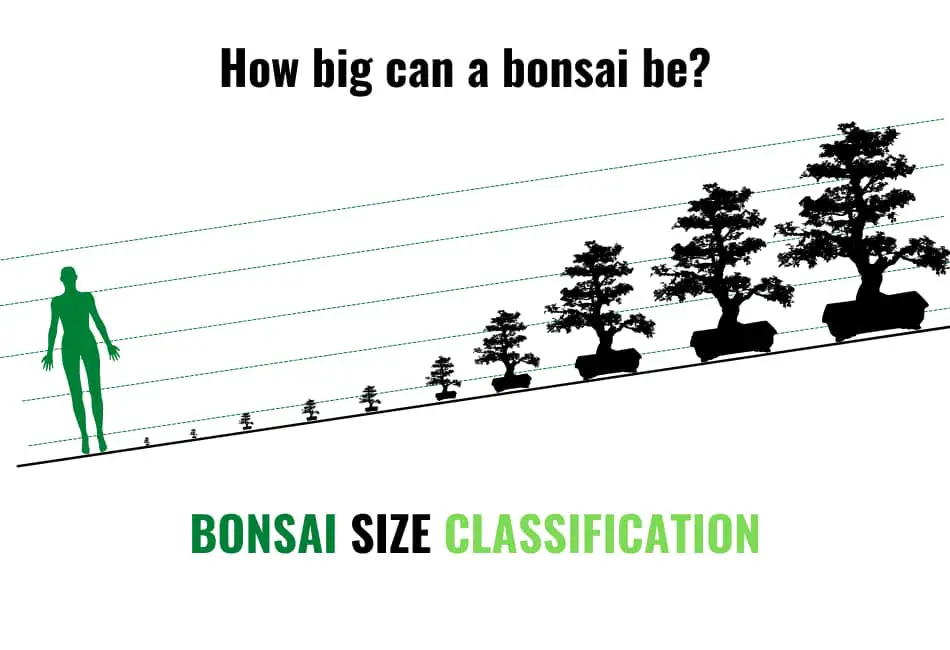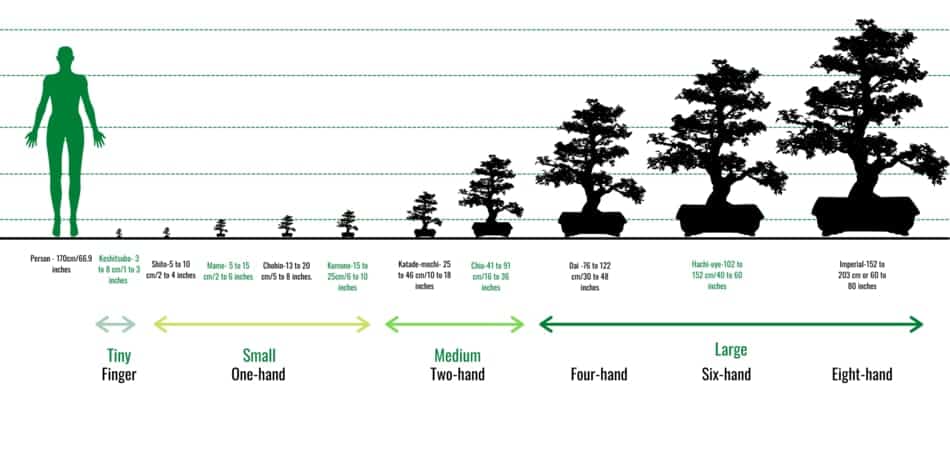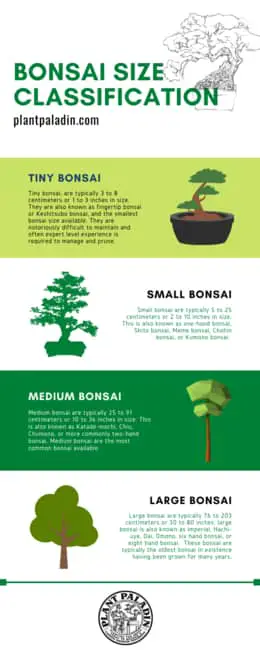This website is supported by its readers. If you click one of my links I may earn a commission. I am also a participant in the Amazon affiliates program and I will also earn a commission from qualified purchases.

One of the things I really struggled with when I first started taking an interest in keeping a bonsai was all the different sizes that were available. With bonsai originating from the far east the names did not come easily to me and so I really struggled with finding a bonsai size classification. Luckily after a lot of painstaking research and speaking to a few bonsai owners and garden centers it became clear.
Keshitsubo, Shito, Mame, Chohin, Kumono, Katade-mochi, Chiu or Chumono, Dai or Omono, Hachi-uye, and Imperial are the different size classifications bonsai trees come in. Keshitsubo is the smallest at 1 to 3 inches (3 to 8cm) with Imperial the largest at 60 to 80 inches (152 to 203cm).
It’s also not uncommon for bonsai to be measured in a variety of hands too with a fingertip bonsai being used to describe keshitsubo and an 8 hand bonsai being used to describe imperial bonsai.
So what exactly are the differences in specific sizes with these bonsais, and what is bonsai size classification? Keep reading to find out more!
Just a quick heads up, over the past three years of running Plantpaladin, hundreds of people have asked for product recommendations. As such, You can find my favorite indoor bonsai tree here (link takes you to Bonsaiboy), my favorite outdoor bonsai tree (link takes you to Bonsaiboy), or have a look at all the products I recommend here.
Bonsai size classification
Bonsai is one of those rare horticulture/art forms that really is up to the owners as to how they want their plants to look.
Want to have a collection of huge 1 meter+ bonsais to fill your garden – go ahead.
Want a mini nursery full of fingertip bonsai – go for it!
That being said, in order for bonsai competitions or just general classification coming up with a bonsai size classification is incredibly important.
This allows owners to separate out tiny finger bonsai from a larger 1 meter plus bonsai.
The classification then it’s broken down in the following way:
- Keshitsubo – a fingertip bonsai that is 3 to 8 centimeters or 1 to 3 inches in size
- Shito – a one-handed bonsai that is 5 to 10 centimeters or 2 to 4 inches
- Mame – a one-handed bonsai that is 5 to 15 centimeters or 2 to 6 inches
- Chohin – a one-handed bonsai that is 13 to 20 centimeters or 5 to 8 inches
- Kumono – a one-handed bonsai that is 15 to 25 centimeters or 6 to 10 inches
- Katade-mochi – a two-handed bonsai that is 25 to 46 centimeters or 10 to 18 inches
- Chiu or Chumono – a two-handed bonsai that is 41 to 91 centimeters or 16 to 36 inches
- Dai or Omono – a four-handed bonsai that is 76 to 122 centimeters or 30 to 48 inches
- Hachi-uye – a six-handed bonsai that is 102 to 152 centimeters or 40 to 60 inches
- Imperial – an eight-handed bonsai that is 152 to 203 centimeters or 60 to 80 inches
Anything larger than an imperial bonsai would be classified as a regular tree.
Now, this is obviously quite a lot of information to take in so to help make this a little easier I’ve put together a table below:
|
Classification | Size inches | Size Centimeters | Hand size |
General size |
| Keshitsubo | 1 to 3 inches | 3 to 8 centimeters | Fingertip | Tiny |
| Shito | 2 to 4 inches | 5 to 10 centimeters | One-hand | Tiny |
| Mame | 2 to 6 inches | 5 to 15 centimeters | One-hand | Small |
| Chohin | 5 to 8 inches | 13 to 20 centimeters | One-hand | Small |
| Kumono | 6 to 10 inches | 15 to 25 centimeters | One-hand | Small |
| Katade-mochi | 10 to 18 inches | 25 to 46 centimeters | Two-hand | Medium |
| Chiu or Chumono | 16 to 36 inches | 41 to 91 centimeters | Two-hand | Medium |
| Dai or Omono | 30 to 48 inches | 76 to 122 centimeters | Four-hand | Large |
| Hachi-uye | 40 to 60 inches | 102 to 152 centimeters | Six-hand | Large |
| Imperial | 60 to 80 inches | 152 to 203 centimeters | Eight-hand | Large |
Now without any visual aids, this can be a little confusing so hopefully, the infographic and images below should help:


Why do people use bonsai size classification?
Bonsai size classification is used as a way to determine the varying size of bonsai trees. This is useful information to use when purchasing bonsai online, or when considering entering your bonsai tree into the competition.
Smaller Keshitsubo is more difficult to maintain and so classifications can help in competition ensuring you do not enter your bonsai in the wrong category.
Size classifications are also useful in determining the age of bonsai with older bonsai more likely to be larger imperial or Hachi-uye.
How big are the jumps between bonsai size classification?
Tiny and small bonsai classifications such as Keshitsubo, Mame, or Kumono only jump two to five centimeters (one to two inches) between size classifications. Large bonsai classifications such as imperial or Hachi-uye tend to jump 20 to 50cm between size classifications (7 to 19 inches).
Medium bonsai classifications such as Katade-mochi or Chiu jump around ten centimeters between classifications or 3.9 inches.
It’s safe to say then that tiny and small bonsai species will change classification the most, more frequently meaning if you would like your bonsai to stay in the size classification that it is in, it will require you to do a lot more work.
Why do bonsai size classifications use hands?
Bonsai trees are measured in hands as it gives the bonsai owner a good identifier of how many hands are needed to move the bonsai. Before people measured with rulers, hand classifications were also used as an early accurate measurement of bonsai size classification.
Meaning if a bonsai needed to be traded, its size could be easily communicated.
Hand classifications are still used to this day, and despite some variation in the size of a bonsai, it help give a great shorthand on the size of a bonsai tree.
The different hand classifications are as follows:
Fingertip – Tiny bonsai that are three to eight centimeters or one to three inches in size. also known as Keshitsubo
One-hand – Small bonsai that are 5 to 25 centimeters or 2 to 10 inches in size.
Two-hand – Medium bonsai that are most common amongst bonsai owners. They are 25 to 91 centimeters or 10 to 36 inches
four-hand – Large bonsai that are 76 to 122 centimeters or 30 to 48 inches
Six-hand – Large bonsai that are 102 to 152 centimeters or 40 to 60 inches
Eight-hand – Large bonsai that are 152 to 203 centimeters or 60 to 80 inches
What are bonsai size classifications?
Bonsai size classifications are a classification system used to indicate the size of a bonsai tree. This is either done through a hand size classification determining how many hands are used to move a bonsai, or through traditional Japanese words such as Keshitsubo or Mame.
Knowing your bonsai size classification can help aid you in the pruning and care techniques you give with smaller bonsai size classifications such as Keshitsubo needing very different aftercare than larger size classifications such as Imperial bonsai trees.
What bonsai size classification is the most common?
The most common bonsai size classification is Katade-mochi, Chiu, or Chumono. This is for medium-sized that fall in the range of 25 to 91 centimeters or 10 to 36 inches. This size classification is also known as two-hand bonsai trees.
What is Keshitsubo bonsai size classification?
Keshitsubo bonsai size classification is for bonsai trees that are three to eight centimeters or one to three inches in size. It is the smallest bonsai size available and is also known as fingertip bonsai.
What is Shito bonsai size classification?
Shito bonsai size classification is for bonsai trees that are five to ten centimeters or two to four inches. It is the second smallest bonsai size available and falls into the one-hand bonsai category.
What is Mame bonsai size classification?
Mame bonsai size classification is for bonsai trees that are 5 to 15 centimeters or 2 to 6 inches. It is the third smallest bonsai size available and falls into the one-hand bonsai category.
What is Chohin bonsai size classification?
Chohin bonsai size classification is for bonsai trees that are 13 to 20 centimeters or 5 to 8 inches. It is the fourth-smallest bonsai size available and falls into the one-hand bonsai category.
What is Kumono bonsai size classification?
Kumono bonsai size classification is for bonsai trees that are 15 to 25 centimeters or 6 to 10 inches. It is the largest small bonsai size available and falls into the one-hand bonsai category.
What is Katade-mochi bonsai size classification?
Katade-mochi bonsai size classification is for bonsai trees that are 25 to 46 centimeters or 10 to 18 inches. It is the smallest bonsai that falls into the two-hand bonsai category.
What is Chiu or Chumono bonsai size classification?
Chiu, also known as Chumono, bonsai size classification is for bonsai trees that are 41 to 91 centimeters or 16 to 36 inches. It is the largest-sized bonsai that falls into the two-hand bonsai category.
What is Dai or Omono bonsai size classification?
Dai or Omono bonsai size classification is for bonsai trees that are 76 to 122 centimeters or 30 to 48 inches. It falls into the four-hand bonsai category.
What is Hachi-uye bonsai size classification?
Hachi-uye bonsai size classification is for bonsai trees that are 102 to 152 centimeters or 40 to 60 inches. It falls into the six-hand bonsai category.
What is Imperial bonsai size classification?
Imperial bonsai size classification is for bonsai trees that are 152 to 203 centimeters or 60 to 80 inches. It falls into the eight-hand bonsai category. It is the largest bonsai size available and was popularised in the past by emperors of Japan.
What is the size of a tiny bonsai?
Tiny bonsai, are typically three to eight centimeters or one to three inches in size. They are also known as fingertip bonsai or Keshitsubo bonsai, and the smallest bonsai size available. They are notoriously difficult to maintain and often expert level experience is required to manage and prune.
What is the size of a small bonsai?
Small bonsai are typically 5 to 25 centimeters or 2 to 10 inches in size. This is also known as one-hand bonsai, Shito bonsai, Mame bonsai, Chohin bonsai, or Kumono bonsai.
What is the size of a medium bonsai?
Medium bonsai are typically 25 to 91 centimeters or 10 to 36 inches in size. This is also known as Katade-mochi, Chiu, Chumono, or more commonly two-hand bonsai. Medium bonsai are the most common bonsai available.
What is the size of a large bonsai?
Large bonsai are typically 76 to 203 centimeters or 30 to 80 inches. large bonsai is also known as imperial, Hachi-uye, Dai, Omono, six hand bonsai, or eight hand bonsai. These bonsai are typically the oldest bonsai in existence having been grown for many years.
How tall should bonsai be?
So using the size classifications we have laid out in this article we can come to a few considerations about the maximum size and height a bonsai tree should be.
The tallest a bonsai tree should be is 203 to 210 centimeters or 80 to 82 inches. Any taller than this and bonsai trees will just be a regular tree. Most tall bonsai trees are between 76 to 203 centimeters or 30 to 80 inches.
How small can a bonsai be?
Now for those of you who are on the other end of the spectrum, you might only have a small bit of room to grow bonsai but this doesn’t have to stop you.
The smallest a bonsai tree can be is three to eight centimeters or one to three inches in size. This falls under the fingertip category size for bonsai tree and most commonly know as Keshitsubo in most size classifications.
Just be aware that growing a bonsai at this size can be incredibly difficult.
Wrapping things up
I appreciate we have gone through quite a lot of information in this post today but to summarize:
- Bonsai trees are broken up into different categories to help bonsai owners understand the different sizes bonsai trees come in.
- Keshitsubo, Shito, Mame, Chohin, Kumono, Katade-mochi, Chiu or Chumono, Dai or Omono, Hachi-uye, and Imperial are the different size classifications bonsai trees come in
- Bonsai trees can also be categorized in hand systems ranging from fingertip, one-hand, two-hand, four-hand, six-hand, and eight hands.
A full breakdown of bonsai size classifications can be found in the table below:
|
Classification | Size inches | Size Centimeters | Hand size |
General size |
| Keshitsubo | 1 to 3 inches | 3 to 8 centimeters | Fingertip | Tiny |
| Shito | 2 to 4 inches | 5 to 10 centimeters | One-hand | Tiny |
| Mame | 2 to 6 inches | 5 to 15 centimeters | One-hand | Small |
| Chohin | 5 to 8 inches | 13 to 20 centimeters | One-hand | Small |
| Kumono | 6 to 10 inches | 15 to 25 centimeters | One-hand | Small |
| Katade-mochi | 10 to 18 inches | 25 to 46 centimeters | Two-hand | Medium |
| Chiu or Chumono | 16 to 36 inches | 41 to 91 centimeters | Two-hand | Medium |
| Dai or Omono | 30 to 48 inches | 76 to 122 centimeters | Four-hand | Large |
| Hachi-uye | 40 to 60 inches | 102 to 152 centimeters | Six-hand | Large |
| Imperial | 60 to 80 inches | 152 to 203 centimeters | Eight-hand | Large |
Now if you are reading this you are likely at the start of your bonsai journey I would definitely recommend having a look at the following posts:
- How to thicken bonsai branches
- What is bonsai ramification
- Are bonsai trees poisonous to humans
- How long do bonsai trees live?
My top picks for the gear you will need!
So like I mentioned earlier, over the past three years of running PlantPaladin, hundreds of people have asked me for my recommendations on the best bonsai gear on the market.
Having spent thousands of dollars on bonsai items these past few years and tested at least 100 bonsai-specific products, I’ve listed my favorite products below – All of which I highly recommend and think you can get great value.
They can purchase directly by clicking the link to take them to Amazon.
Bonsai Tool Set: One of the significant challenges I’ve had is finding a toolset that was not only durable but didn’t break the bank. SOLIGT has recently developed a fantastic bonsai tool set that covers all the tools you need to trim, prune, and repot your trees. – You can grab it here.
Complete Bonsai Set: Many of you will want to grow your bonsai trees entirely from scratch, but finding the varicose seeds, pots, and other items in one place can be challenging. Leaves and Sole then have created a complete bonsai set that I’ve personally used that ticks all the boxes. You can grab it here.
Bonsai wire: The number of times I’ve run out of wire for my bonsai or purchased cheap bonsai wire that doesn’t do the job is embarrassing for me to admit. After a lot of trial and error, I found that using Hotop’s aluminum bonsai wire is one of the best options on the market. This can easily be used for both indoor and outdoor bonsai. You can grab it here.
This post was written by Fehed Nicass who has been passionate about bonsai for over 2 years. He currently resides in the UK and works in sales.
